Dr. Ben Carson boarded a flight to the Middle Eastern nation of Jordan late on Thanksgiving to embark on a tour of Syrian refugee camps there on Friday, he told Breitbart News in an exclusive interview before the trip.
The tour–which Carson is taking so he can learn more about how to solve the refugee crisis by resettling Syrians throughout the Middle East, rather than bringing any refugees to the United States of America or placing more in Europe–means the world-leading neurosurgeon is the first 2016 GOP presidential candidate to tour refugee camps in Jordan.
“I’m going to be visiting some of the refugee camps and some of the hospitals and talking to some of the people,” Carson told Breitbart News in the exclusive phone interview on Thursday afternoon.
I want to get a really good impression of what’s going on over there with these refugees. There’s a lot of Syrian refugees. There are not nearly as many as they had planned for. But as you may or may not know, the facilities are not conducive to having any refugees stay there—they’re trying to get out of there. Also, I want to get a better impression of why Jordan, Saudi Arabia, Kuwait, UAE, why are they so resistant to integrating Syrians into their populations? What is it, what’s the dynamic between these various groups that makes them not want to help each other? I really want to get to the bottom of that.
Part of the reason why he’s going is because Carson envisions a future where ISIS is decimated and wants to find solutions for how to proactively deal with large-scale problems in the Middle East before they get out of control again.
“I want us not to give up on the possibilities of peace over there,” Carson told Breitbart News.
I’m not being unrealistic or saying that we ought to sit down with a peace pipe with ISIS—that’s just absurd. But let’s say we get rid of ISIS: There’s still a lot of work to be done over there. And I think we’re a central part of that. We have been a very big part of that for many decades and the American influence, even though we were taking sort of a back seat and leading from behind, it’s still very powerful. It needs to be cultivated in the right way. And that influence used in the right way not only leads to peace but increased quality of life for people because one of the things that an organization like ISIS springs up is because they appeal to the desperation of people who have no hope. We can help alter that dynamic.
Carson said he wants to find a solution to resettle the refugees closer to their homeland throughout the Middle East—and that he doesn’t think the United States should be taking any here.
“For me it’s not so much about taking refugees in here—I just don’t think that’s a good idea from the outset,” Carson said hours before heading to Jordan. “It’s really more about understanding the dynamic over there because I think we need to be working with some of the nations over there in terms of how do you resettle? And in terms of how do we form some kind of a coalition where you have peace and repatriate? That’s what I’m looking for. I just think it’s wrongheaded that the only solution is for us to take them here. That’s not the right solution.”
Jordan is one of the few countries in the ummah (Islamic world) that has aggressively provided for refugees fleeing from war-torn Syria.
The UNHCR, the United Nations’ refugee agency, has taken point in providing assistance for refugees from Syria who live in Jordanian refugee camps. By the end of 2015, Jordan will have taken in over one million refugees, over 90% of whom came from Syria, while the rest will have arrived mostly from Iraq, according to UN data.
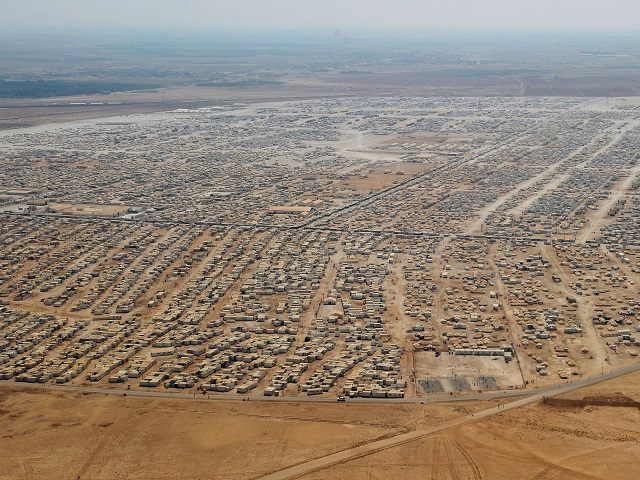
An aerial view shows the Zaatari refugee camp, near the Jordanian city of Mafraq July 18, 2013. The camp that holds roughly 115,000 Syrian refugees in Jordan about 12 km (eight miles) from the Syrian border. REUTERS/Mandel Ngan/Pool
Carson ripped President Barack Obama for comparing, as the president did in his Thanksgiving address, potential Syrian refugees in the United States to the Pilgrims.
“That’s certainly not the way I see it,” Carson said when asked to respond to Obama’s comments. “If they were Pilgrims, they should be Pilgrims over there, not Pilgrims over here.”
Obama had on Thursday morning compared Syrian refugees to the Pilgrims who settled in Plymouth, Massachusetts, nearly 400 years ago—who kicked off the tradition of Thanksgiving.
“In 1620, a small band of pilgrims came to this continent, refugees who had fled persecution and violence in their native land,” Obama said. “Nearly 400 years later, we remember their part in the American story – and we honor the men and women who helped them in their time of need.”
Carson told Breitbart News that what would be a truly “humanitarian act,” one of “Christian love,” would be finding ways to reintegrate Syrian refugees into Middle Eastern nations like Jordan—where he’s touring on Friday—and society there, rather than bringing them here.
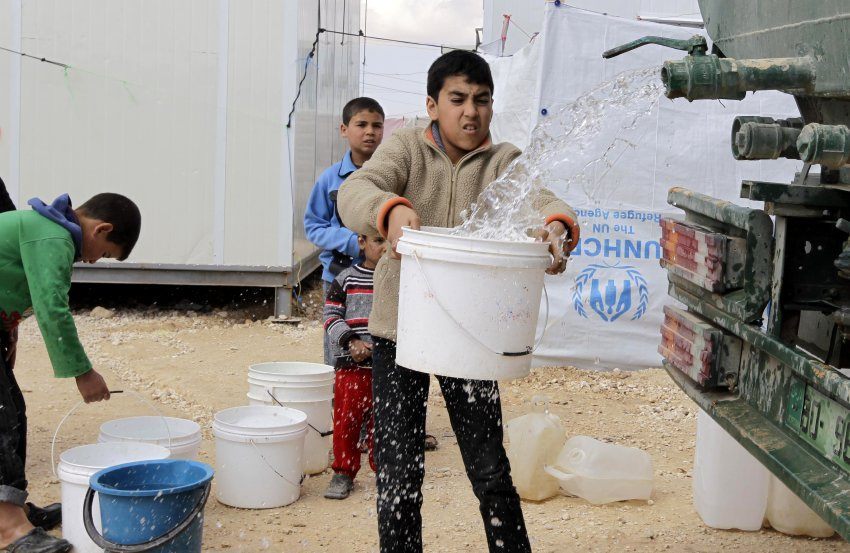
A picture taken on March 15, 2014 shows children collecting water from a truck at the sprawling desert Zaatari refugee camp in northern Jordan near the border with Syria which provides shelter to around 100,000 Syrian refugees. AFP PHOTO/KHALIL MAZRAAWI
“But again, we must get back to thinking: exactly what is a humanitarian act? What truly is an act of Christian love? And I think it is not running away from the situation over there,” Carson said.
It’s trying to ameliorate the situation over there so that people can live in peace. I think there’s been a premature capitulation to violence and evil. And I just don’t think we have to get in and say there’s no hope and no point to try to achieve some fairness over there, that there’s no point in trying to get some of the people who have refugee camps to let the people out of the refugee camps and let them work. Many of them are people with skills—doctors, lawyers, dentists—who could be there helping. Why would you take people with those kinds of skills and just confine them to a refugee camp where they live on $95 a month? It just doesn’t make any sense.
Jordanian government agencies, along with several NGOs and international partners, contribute to the relief efforts for refugees in the country.
Amman opened the Zaatari refugee camp, located near the Syrian border, in 2012 to deal with Syrians fleeing the violence and turmoil of the war in their nation.
Documenting the initial surge of Syrians into Zaatari camp, journalist Carla Fibla wrote in 2012: “Every day, thousands of Syrian refugees walk early in the morning to the entrance of Za’atari camp and form a long queue. For hours, they wait for lorry deliveries, fighting for each centimetre of space.”
The refugee population in Zaatari alone is estimated at around 83,000 people. Due to the continuing increase in population, the camp has faces a surge in crime and drug issues. The camp was said to reach maximum capacity when its population totaled 60,000, but its gates remain open.
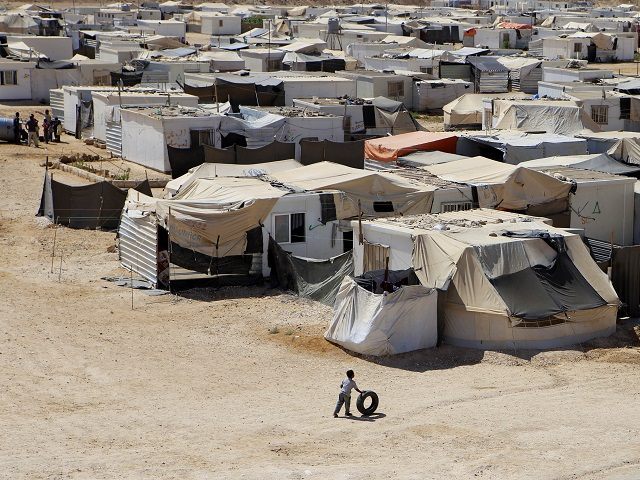
In this Wednesday, July 29, 2015 photo, a Syrian refugee boy plays with a tire at Zaatari refugee camp, in Mafraq, Jordan. (AP Photo/Raad Adayleh)
The conditions in Zaatari have become so rough for refugees that some now prefer to leave and take their chances in Syria, according to reports.
Majreeb Al Fhood refugee camp, located near Zaatari, has become another popular spot for Syrian refugees. Its current population stands at a little over 4,000, according to estimates from early 2015. The camp was built to deal with the over-population in the Zaatari camp.
But 80 percent of the Syrian refugees don’t live in refugee camps. They are dispersed among urban populations in the country’s north–which has become dramatically reshaped, both from a security and a demographic standpoint, due to the war.
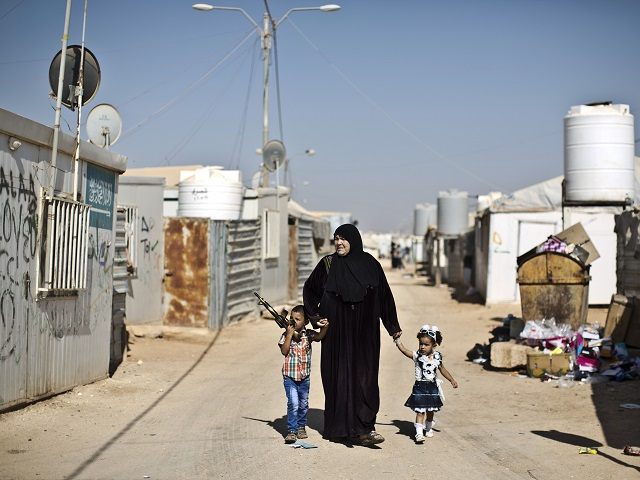
Syrian refugee children dressed in new clothes hold the hands of their grandmother while walking back to their shelter on the first day of the Eid al-Fitr holiday that marks the end of the holy fasting month of Ramadan at Zaatari refugee camp, in Mafraq, Jordan, Friday, July 17, 2015. (AP Photo/Muhammed Muheisen)
Carson, a doctor and world-renowned pediatric neurosurgeon, also said that he’s planning to visit hospitals there. He compared this fact-finding mission to his August trip to the U.S. border with Mexico in Arizona, a trip on which this reporter accompanied him for Breitbart News and included a helicopter tour of cartel-controlled territory deep inside the United States.
“I’m hoping not only to see the refugees and the refugee camps, but I’m also hoping to be looking at the hospitals and how some of the children who are injured are being taken care of and what other services could potentially be offered to all the people from a physical standpoint,” Carson said.
I think unless we know those kinds of things we can’t do the right thing in these negotiations. I learned so much last summer when I went down to the border. We all knew that the border is porous but to actually be there and to see it for yourself, to talk to the ranchers down there and hear their horror stories and talk to the sheriffs and the deputy sheriffs and hear what they go through and how they risk their lives protecting these people. You can’t really appreciate it until you see it. That’s what I think will happen here: I actually want to see the conditions, I want to hear from them, where they came from, what would be for them the ideal kind of outcome, what do they think is keeping them from getting there? Who are their friends? Who are their enemies? And I want to hear from a bunch of people. That’s really how you form a solution as opposed to hearing from media outlets who are trying to distort it and be inaccurate.
Popular NGOs and humanitarian organizations, such as Doctors Without Borders, the International Rescue Committee, Save The Children, and dozens of other non-profits have come to Jordan in hopes to better the lives of those in desperate conditions.
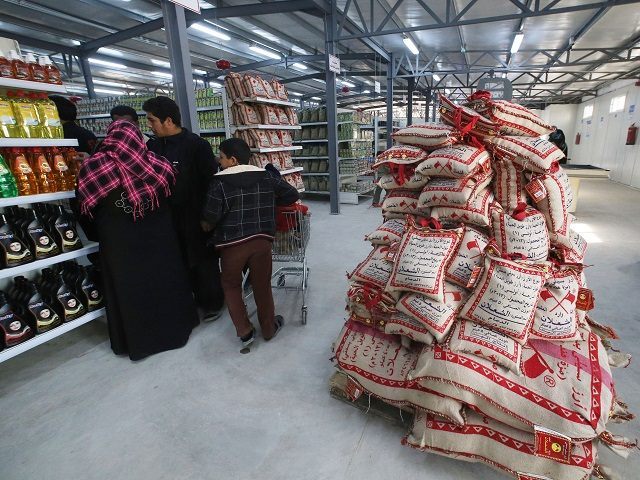
Syrian refugees shop at the first hypermarket that is opened in Zaatari camp for Syrian refugees on February 6, 2014 in Jordan. With vouchers refugees can choose from a diverse list of food that are not normally included in conventional food rations. The voucher has a value of JD18 (U.S.$ 25) per person per month and is complemented by a monthly ration of rice, lentils, bulgur wheat, date bars, sugar and salt. (Photo by Salah Malkawi/ Getty Images)
Jordan, a country with a population of only 6.5 million people, will soon reach a point at which they must refuse entry to Syrians fleeing the war between Syrian dictator Bashar al-Assad and opposition forces. But the conflict continues to see the mass slaughter of innocents, creating a situation where civilians will continue to do all they can to escape Damascus’s borders.
Meanwhile, their Gulf neighbors–such as Saudi Arabia, which already has in place a tent city that can accommodate millions of people–refuse to take in a single refugee.
Carson compared the false choice Washington, D.C., is presenting–of either letting the Syrian refugees into this country and Europe or seeing them be killed–to the Iranian nuclear deal.
“Which of course is the same kind of thing we get with Iran—which is we either have to go to war with Iran or we have to sign this ridiculous deal when of course there are other choices,” Carson said, adding that this trip will help him understand firsthand choices and solutions that are different from what the mainstream media and permanent political class are putting forward.
“What kind of conditions are there, and what can be done to improve them? But also, what kind of humanitarian help is necessary? We have the ability to do a lot and many other nations have the ability to do a lot too.”
Carson wouldn’t call on the rest of his 2016 competition to take similar tours of refugee camps, but he did say he thinks this puts him at an advantage to have a real solution to the problem.
“I never like to tell other candidates what they should do or what they should think, I just think that when I get to see things and experience them for myself rather than have them filtered through other people it makes a much bigger impression,” Carson told Breitbart News when asked if he thinks everyone running should go. “Maybe the other people don’t need that—I don’t know. But I find it extraordinarily helpful.”
Carson also laid out his strategy to defeat ISIS and how he’d do things differently from President Obama so far.
“First of all, I believe we have to really take the battle to ISIS and the goal has to be to eliminate them, not contain them or push them into one area,” Carson said.
And in order to do that we have to look at what works and what doesn’t work. What has worked just recently when you look at the gains we’ve had in Syria by associating ourselves with the Kurds and allowing them to cut off supply lines to Sinjar, that city, that weakened it. Then when the Kurdish military forces went in with our special ops supported by air, they were able to topple that fairly quickly. That worked. That’s a strategy that’s very effective. There is no reason that can’t work in some of the other cities, including Mosul.
Then, when you use your social media and all your other media to blast—remember how when they took the city, it’s all over the place? It makes them look like the big guy. We need to just the same thing. You take it back from them and make them look like the little guy.
We need to do the same thing in the southern part of Iraq. They got a bad rap because in their face-off with ISIS they turned tail and ran and left all the millions of dollars of equipment which ISIS then inherited. Well, we didn’t do it the same way there as we did it with Sinjar. We didn’t have an adequate number of special forces. You have to have those there. You have to have Apache helicopters, and then all of a sudden the tide turns dramatically and you begin to take back the land, their “Caliphate.: And you blast that all over the world, the account that they’re turning tail and running.
You try to hurt them, their pride, so their pride makes them come out and fight, and when they do, you wipe them out. And then you take their oil, and then you work with the world monetary systems so they have no ability to move money and so they have no ability to pay people. And you just continue to take the battle to them until they’re gone. I think that’s how you fight a war.
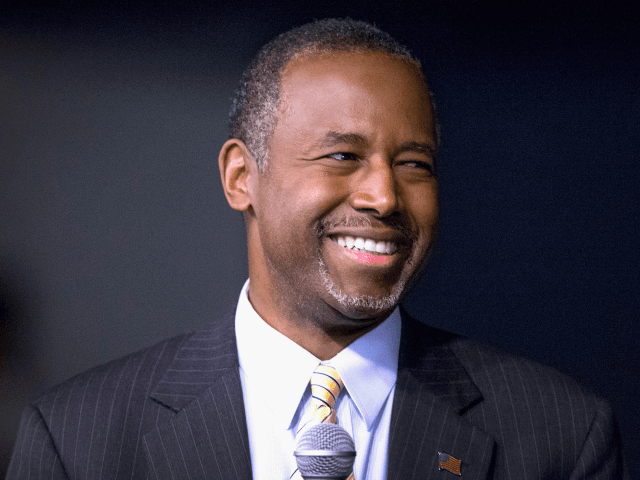
COMMENTS
Please let us know if you're having issues with commenting.